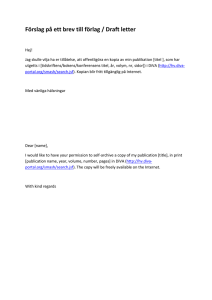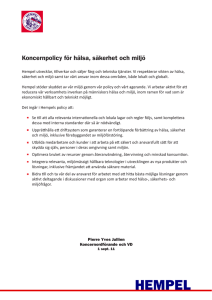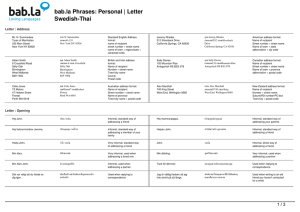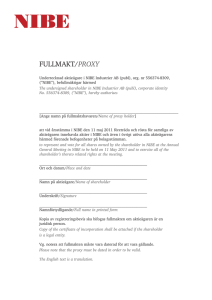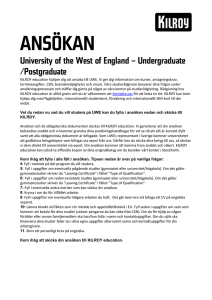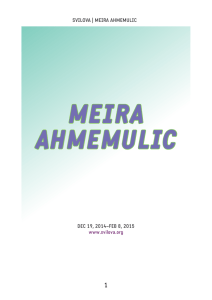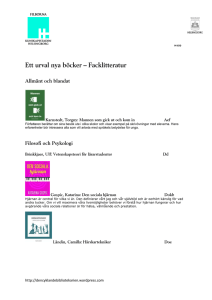När de engelska kolonisatörerna väl hade intagit ett högt beläget
advertisement
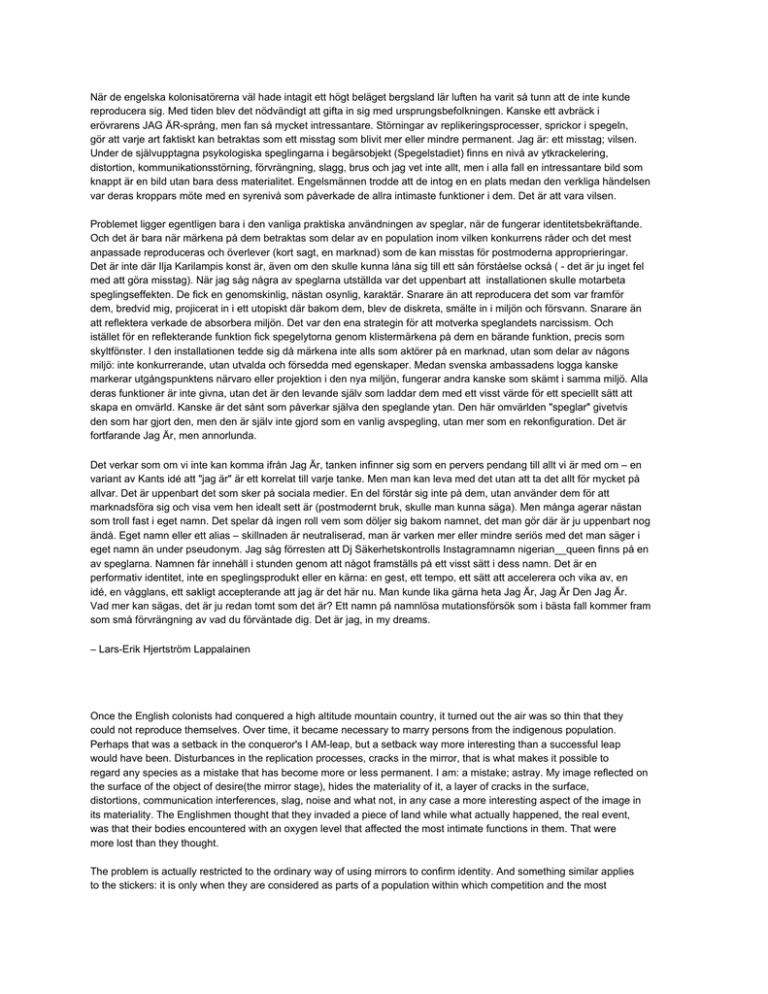
När de engelska kolonisatörerna väl hade intagit ett högt beläget bergsland lär luften ha varit så tunn att de inte kunde reproducera sig. Med tiden blev det nödvändigt att gifta in sig med ursprungsbefolkningen. Kanske ett avbräck i erövrarens JAG ÄR­språng, men fan så mycket intressantare. Störningar av replikeringsprocesser, sprickor i spegeln, gör att varje art faktiskt kan betraktas som ett misstag som blivit mer eller mindre permanent. Jag är: ett misstag; vilsen. Under de självupptagna psykologiska speglingarna i begärsobjekt (Spegelstadiet) finns en nivå av ytkrackelering, distortion, kommunikationsstörning, förvrängning, slagg, brus och jag vet inte allt, men i alla fall en intressantare bild som knappt är en bild utan bara dess materialitet. Engelsmännen trodde att de intog en en plats medan den verkliga händelsen var deras kroppars möte med en syrenivå som påverkade de allra intimaste funktioner i dem. Det är att vara vilsen. Problemet ligger egentligen bara i den vanliga praktiska användningen av speglar, när de fungerar identitetsbekräftande. Och det är bara när märkena på dem betraktas som delar av en population inom vilken konkurrens råder och det mest anpassade reproduceras och överlever (kort sagt, en marknad) som de kan misstas för postmoderna approprieringar. Det är inte där Ilja Karilampis konst är, även om den skulle kunna låna sig till ett sån förståelse också ( ­ det är ju inget fel med att göra misstag). När jag såg några av speglarna utställda var det uppenbart att installationen skulle motarbeta speglingseffekten. De fick en genomskinlig, nästan osynlig, karaktär. Snarare än att reproducera det som var framför dem, bredvid mig, projicerat in i ett utopiskt där bakom dem, blev de diskreta, smälte in i miljön och försvann. Snarare än att reflektera verkade de absorbera miljön. Det var den ena strategin för att motverka speglandets narcissism. Och istället för en reflekterande funktion fick spegelytorna genom klistermärkena på dem en bärande funktion, precis som skyltfönster. I den installationen tedde sig då märkena inte alls som aktörer på en marknad, utan som delar av någons miljö: inte konkurrerande, utan utvalda och försedda med egenskaper. Medan svenska ambassadens logga kanske markerar utgångspunktens närvaro eller projektion i den nya miljön, fungerar andra kanske som skämt i samma miljö. Alla deras funktioner är inte givna, utan det är den levande själv som laddar dem med ett visst värde för ett speciellt sätt att skapa en omvärld. Kanske är det sånt som påverkar själva den speglande ytan. Den här omvärlden "speglar" givetvis den som har gjort den, men den är själv inte gjord som en vanlig avspegling, utan mer som en rekonfiguration. Det är fortfarande Jag Är, men annorlunda. Det verkar som om vi inte kan komma ifrån Jag Är, tanken infinner sig som en pervers pendang till allt vi är med om – en variant av Kants idé att "jag är" är ett korrelat till varje tanke. Men man kan leva med det utan att ta det allt för mycket på allvar. Det är uppenbart det som sker på sociala medier. En del förstår sig inte på dem, utan använder dem för att marknadsföra sig och visa vem hen idealt sett är (postmodernt bruk, skulle man kunna säga). Men många agerar nästan som troll fast i eget namn. Det spelar då ingen roll vem som döljer sig bakom namnet, det man gör där är ju uppenbart nog ändå. Eget namn eller ett alias – skillnaden är neutraliserad, man är varken mer eller mindre seriös med det man säger i eget namn än under pseudonym. Jag såg förresten att Dj Säkerhetskontrolls Instagramnamn nigerian__queen finns på en av speglarna. Namnen får innehåll i stunden genom att något framställs på ett visst sätt i dess namn. Det är en performativ identitet, inte en speglingsprodukt eller en kärna: en gest, ett tempo, ett sätt att accelerera och vika av, en idé, en vågglans, ett sakligt accepterande att jag är det här nu. Man kunde lika gärna heta Jag Är, Jag Är Den Jag Är. Vad mer kan sägas, det är ju redan tomt som det är? Ett namn på namnlösa mutationsförsök som i bästa fall kommer fram som små förvrängning av vad du förväntade dig. Det är jag, in my dreams. – Lars­ Erik Hjertström Lappalainen Once the English colonists had conquered a high altitude mountain country, it turned out the air was so thin that they could not reproduce themselves. Over time, it became necessary to marry persons from the indigenous population. Perhaps that was a setback in the conqueror's I AM­leap, but a setback way more interesting than a successful leap would have been. Disturbances in the replication processes, cracks in the mirror, that is what makes it possible to regard any species as a mistake that has become more or less permanent. I am: a mistake; astray. My image reflected on the surface of the object of desire(the mirror stage), hides the materiality of it, a layer of cracks in the surface, distortions, communication interferences, slag, noise and what not, in any case a more interesting aspect of the image in its materiality. The Englishmen thought that they invaded a piece of land while what actually happened, the real event, was that their bodies encountered with an oxygen level that affected the most intimate functions in them. That were more lost than they thought. The problem is actually restricted to the ordinary way of using mirrors to confirm identity. And something similar applies to the stickers: it is only when they are considered as parts of a population within which competition and the most adapted reproduced and survived ( in short, a market) that they can be mistaken for postmodern appropriations. Ilja Karilampi's art is elsewhere, even if it could lend itself to a postmodern/mirror stag­understanding (nothing's wrong with making mistakes). When I saw some of the mirrors in an exhibition, it was clear that the installation was designed to thwart the mirroring effect. They got a transparent, almost invisible character. Rather than to reproduce what was in front of them, next to me, and project it into a utopian space behind them, they were unobtrusive, they blended with the environment to the point of disappearing. Rather than to reflect, they seemed to absorb the environment. That was one of the strategies to counteract the narcissism of mirrors. And by putting stickers on the mirrors, the important function of their surfaces was no longer to reflect, but to support. In this installation, the stickers did not really function as brands on a market, but as parts of someone's environment: not by competing , but by being selected and provided with features. While the Swedish Embassy's logotype may be a sign of the presence of the place of departure, or its projection in this new place, others may work as a joke in the same environment. All their properties are not given, some of them are there because a living being has charged them with a certain value for a special way to create an environment. Maybe that is the kind of things that affects the way a surface reflects. This environment of course " mirrors" the one who made it, but it is not made as and by an ordinaryreflection. It is more of a reconfiguration . It is still I Am, but different. It seems we can't get rid of I Am, the thought arises as a perverse counterpart to everything we are going through – like Kant's "I am" that is a correlative of every thought . But you can live with it without taking it too seriously. Obviously, that is what is happening in social media. Some still do use them according to old standards, i.e. to promote themselves and show who they ideally are (“not”) (a postmodern use, one might say). But many people behave like gentle trolls, but in their own name. It does not matter who hides behind the name because whatever you say or do there will be obvious enough anyway. Your own name or an alias – the difference is neutralized. People are as serious, or as little serious, speaking in their own name as they are using a pseudonym. By the way, I saw that the name DJ Säkerhetskontroll uses at Instagram, nigerian__queen, figures on one of the mirrors. The names get a character attached to them by presenting something in a certain way, and they change character pretty swiftly. It is a performative identity, not a product of some mirroring: a gesture, a tempo, a way to accelerate and swerve, an idea, a down to earth acceptance that I am here now. One might as well have called oneself I Am, I Am That I Am. What more can be said, it's already empty as it is! A name for the nameless mutation experiments that, at best, appears as small distortions of what you expected. That's me, in a hallucination. – Lars­ Erik Hjertström Lappalainen
